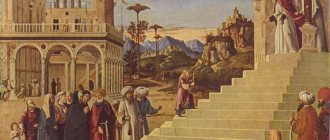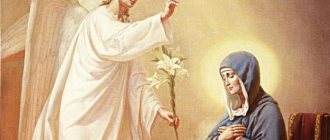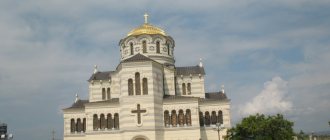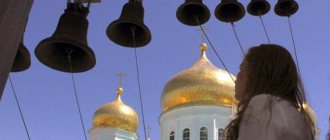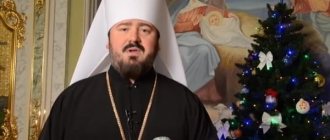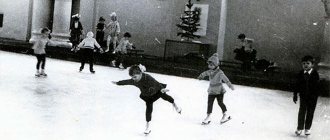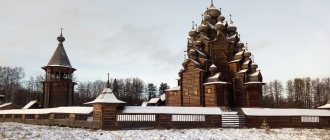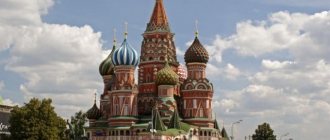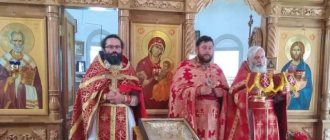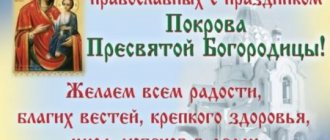January is very rich in various holidays, including church ones. Most Orthodox believe that Christmas is the most important thing. However, the day following this celebration is considered no less important. After all, on January 8, the feast of the Cathedral of the Blessed Virgin Mary is celebrated, which in the old days was much more significant for women than all Christmas services. It's no secret that in Rus' the Mother of God has always been very revered. Numerous temples, monasteries were built in her honor and icons were painted. Many of the images became miraculous and still attract the attention of thousands of pilgrims from all over the world. Today the feast of the Cathedral of the Blessed Virgin Mary is not so well known, but this does not detract from its significance. From our article you will learn about the history of the emergence and development of this celebration. And also about what the feast of the Cathedral of the Blessed Virgin Mary means for all believers and especially women.
Description of the celebration
Our ancestors always visited the temple not only on the seventh, but also on the 8th of January. The holiday of the Cathedral of the Blessed Virgin Mary has a very ancient origin and belongs to the celebrations of the main church circle. There is a tradition in Orthodoxy according to which, after some great holiday, the accompanying celebration is always celebrated. Most often, without those persons whom the church honors on this date, the great holiday simply would not be possible.
Therefore, on the feast of the Synaxis of the Most Holy Theotokos, all believers remember the Mother of God, who revealed the baby Jesus to this world. However, not only is she celebrated on this date; in parallel, Christians glorify those who were involved in the birth of Christ and helped save his life.
Features of Notre Dame Cathedral
The cathedral amazes with its data, which fascinates and plunges any tourist into stupor.
You can imagine these numbers:
- building height – 35 m;
- length of the Cathedral – 130 m;
- the width of the temple is 48 m;
- bell tower height – 69 m;
- the weight of the Emmanuel bell is 13 tons;
- the weight of his tongue is 500 kg.
The unusual architecture of the Cathedral is also surprising, the distinctive feature of which is a certain duality:
- there are elements of the Romanesque style from Normandy: power and strength;
- and here innovative achievements of the Gothic style are used, which give the building lightness and some airiness.
On the top of the Cathedral you can see scary images of gargoyles and chimeras, whose faces evoke mystical horror.
What's inside?
Notre Dame Cathedral in Paris is no less interesting inside than outside. Only here you can see such relics as:
- Crown of thorns of Jesus Christ;
- the largest organ, with 111 stops and about 8,000 pipes;
- paintings and sculptures by various artists, kept in the chapel and donated to the Cathedral annually;
- chandelier of the Cathedral, made of silvered bronze according to the design of Viollet-le-Duc.
You can walk around the Cathedral for hours, looking at the masterfully executed sculptures of the dark Middle Ages and remembering the novel of the same name by the great Victor Hugo.
Being in Paris and not seeing Notre Dame Cathedral is the same as not being in Paris at all. This monument crowns the best sights of Paris and leaves an indelible impression in the heart of every tourist.
Who else is celebrated on January 8th?
On the Orthodox holiday of the Cathedral of the Blessed Virgin Mary, churches remember not only the Virgin Mary. In addition to Her, on this day they pray for three more personalities who are considered close to the Savior in his earthly life:
- Joseph.
- King David.
- Jacob.
Each of these names is well known to the Orthodox. For example, Joseph is called the husband of Mary, which is how he is introduced to us during the Christmas stories. However, clergy can tell a completely different story about the events preceding the birth of baby Jesus. This information relates to the background of Christmas and the feast of the Synaxis of the Blessed Virgin Mary. We will tell readers about this in the next section of the article.
Worship and church status
Notre-Dame de Paris serves as the cathedral of the Archdiocese of Paris, and the seat of the Parisian Archbishop is located here (since 2005, the post has been occupied by André Ven-Trois). On special occasions, the Archbishop of Paris leads liturgical services in the cathedral. The priest responsible for liturgical activities in the cathedral is appointed by the archdiocese and bears the title of rector of the cathedral (French “recteur-archiprêtre”). Since 2021, this post has been held by Patrick Chauvet. Notre Dame Cathedral is one of the five churches in Paris that bears the honorary title of minor basilica.
Divine services in the cathedral are held regularly; on weekdays and Saturdays there are four masses and a vesper service (Vesperae) every day, on Sunday there are five masses, matins (Laudes) and vespers. Some of them take place on the main altar of the cathedral, some in chapels. Sunday evening Mass takes place on the high altar and is usually presided over by the Archbishop.
Feast of the Cathedral of the Blessed Virgin Mary: history of the holiday
Ancient books mention that at the time Joseph became the betrothed husband of the Virgin Mary, he was already eighty years old. Our Lady was entrusted to him to preserve Her life and purity. Joseph was previously married and had several children. It was one of his sons, Jacob, who went with the born Savior to Egypt in order to preserve His life, as well as to save his father and Mary herself from the power of King Herod. It is noteworthy that not too much is known about Joseph. He was considered a very pious man and it was because of this that he was chosen to play the role of the man protecting the Mother of God. This became his most important service to the Lord, which Joseph went through from beginning to end.
I would like to clarify that Jacob, like his father, was very pious and after the martyrdom of Christ and his resurrection from the dead, he became the leader of one of the first Christian churches.
It is impossible not to mention King David. His name is remembered on the feast of the Council of the Blessed Virgin Mary because he is the ancestor of Christ, and they come from the same family.
If you are interested in the background of the church holiday, then the clergy talk about the miraculous salvation of the baby from the wrath of Herod. The king was waiting for the wise men who came to his lands with gifts for the newborn to reveal his location. However, they never succumbed to Herod’s persuasion and secretly left his kingdom. Enraged, he ordered his soldiers to destroy absolutely all the babies in the city of Bethlehem and its immediate surroundings. However, Joseph saw in a dream an angel sent to him with a warning. The angel commanded him to immediately get up, take his family and flee to Egypt to save their lives. Joseph followed the words he heard and was able to avoid a sad fate.
Many years later, the angel again appeared to Joseph and informed him of the death of Herod, commanding him to return to Bethlehem. The holy elder again submitted to the will from above, but he did not dare to settle in the same city where the son of the cruel king now ruled. Together with his family, Joseph went to Nazareth, where he settled.
By saving the lives of Christ and the Mother of God, he fulfilled his main purpose. Therefore, she is honored almost on a par with the Virgin Mary on the feast of the Synod of the Blessed Virgin Mary.
From the history of the temple
The temple was consecrated in 1713. Three years later, Peter I came to Nizhny Novgorod to serve a prayer service on the occasion of his 50th birthday. Legend has it that the emperor left the temple in anger, ordering it to be closed, which was done. Services resumed 2 years after the death of the king, in 1727.
The Emperor discovered two icons in the church, which he personally ordered from the master Caravac for the Peter and Paul Cathedral in St. Petersburg. Grigory Dmitrievich Stroganov, seeing the icons in the artist’s workshop, bought them secretly from the sovereign, asking the master to paint others for the Peter and Paul Church.
Here another circumstance was revealed that infuriated the hot-tempered emperor. A serf icon painter who studied in Holland at the expense of Grigory Dmitrievich Stroganov, painted the icon “Savior Almighty” .
In the image of Christ, the master depicted the customer of the temple, Grigory Dmitrievich. Peter I, seeing the image, angrily exclaimed: “Should I worship Grishka Stroganov, my servant? This won’t happen!”
The temple burned three times. At the expense of the grandson of the founder of the temple, Alexander Sergeevich, the temple was restored in 1812, strengthened with an additional wall.
In 1930 the temple was closed. During the Great Patriotic War, the building was used as a pharmacy warehouse, thanks to which the ancient iconostasis was preserved - 43 out of 46 icons of the late 17th century survived. In the 60s of the 20th century, the Stroganov Church was transferred to the local history museum.
In 1993, the temple was re-consecrated by Metropolitan Nicholas. The consecration was attended by representatives of the regional administration, the Grand Duchesses Leonida Georgievna and Maria Vladimirovna Romanov, as well as the youth prince George and the director Nikita Mikhalkov who accompanied them, who helped restore the temple.
The formation of a church holiday
The Feast of the Cathedral of the Blessed Virgin Mary has been celebrated for a very long time; its formation occurred almost parallel to the development of the Christian Church. Around the fourth century, many clergy and holy elders wrote that at Christmas it was imperative to remember and honor the Mother of God. They taught Christians in their texts and advised them how to properly celebrate this holiday.
For many centuries, believers treated Christmas exactly as the holy men commanded them, but around the end of the seventh century, the Ecumenical Council made a different decision regarding this date. It is worth noting that the clergy participating in the Council often established rules that in the future became the norm for the entire Church. Therefore, the decision made to separate Christmas and honoring the Mother of God was perceived as a direct instruction for all Christians. Since this period, Orthodox Christians have brought congratulations on the feast of the Synaxis of the Most Holy Theotokos to each other on January 8th. To this day, this date has not changed; moreover, it is worth considering that it is constant and does not depend on other holidays, like many other church celebrations.
With an icon of the Mother of God around his neck
To get to the Annunciation Cathedral, you had to arrive long before 7 am - the time when the service began. A column of priests with banners was already lined up at the temple, led by a truck on which the bells were placed. Most people were waiting outside. Volunteers, dressed in green vests with the inscription “Orthodox Youth of Tatarstan” on the back, handed out masks and icons of the Virgin Mary to everyone, which could be hung around the neck like a badge. Everyone was in high spirits, people congratulated each other on the holiday, wondering whether they would be able to venerate the shrine today.
After a short service, the miraculous icon, framed by a wreath of fresh flowers, was carried out of the Annunciation Cathedral on a stretcher. The police and National Guard immediately stood on both sides of her. The crowd of thousands closed in, and the procession headed towards the Spasskaya Tower. The women's choir sang a prayer, which was echoed by the believers. The smell of incense filled the air, which was used to fumigate the miraculous image.
After a short service, a miraculous icon framed with a wreath of fresh flowers was carried out of the Annunciation Cathedral on a stretcher.
When leaving the Kremlin, the procession was greeted by the ringing of bells from the belfry of the St. John the Baptist Monastery. Passers-by stopped, crossed themselves, and took photographs. Even the law enforcement officers couldn’t resist filming what was happening on their phones.
The religious procession headed down to the Taynitskaya Tower. There were so many people that it was impossible to see the tail of the procession. We had to walk quite quickly, which is why many lowered their masks. “Good people, wear masks!” - Orthodox volunteers exclaimed every now and then.
The head of the column went far ahead, and the priest, who was monitoring the order of the ranks, was forced to stop it using the loudspeaker and hurry up the tail. “Fathers, hurry up!” - he commanded his colleagues carrying the icon. At the embankment, both parts closed and then moved on in an orderly column.
The passage to the Bogoroditsky Monastery was blocked, people were released in small groups
What does the Feast of the Synaxis of the Blessed Virgin Mary mean?
We have already talked in part about the significance of this church celebration in the previous sections of the article. But let us briefly repeat: it is impossible to celebrate the birth of Christ without remembering those who were next to him and became helpers of the future Savior. After all, every person who found himself next to the baby after his birth was not accidental. Therefore, on January 8th, Orthodox Christians come to the temple and pray in front of the icons of the Virgin Mary, praising her, Joseph, Jacob and King David.
Usually, mostly women come to church on this day. They are the ones who bring their problems and concerns to the Mother of God. It is believed that she understands all women’s troubles as well as possible and never leaves requests unattended. Therefore, for unmarried and married representatives of the fair sex, the Virgin Mary is an intercessor. And the holiday is another reason to thank her for her help and make another request. Many say that it is on the eighth of January that the Mother of God is especially attentive to the tears and problems of earthly women.
Guests of the ceremony
Following the clergy, guests spoke at the Cathedral of the Kazan Icon of the Mother of God. Tatarstan President Rustam Minnikhanov congratulated everyone present on a significant day in the history of the entire Orthodox world.
“Exactly five years ago, we, led by His Holiness Patriarch Kirill, laid the first stone in the foundation of the reconstructed temple. And today, in this majestic cathedral, in the presence of the patriarch and distinguished guests, the Divine Liturgy is celebrated again. The capital of Tatarstan and our glorious fatherland have found one of their main spiritual shrines,” said Rustam Minnikhanov.
Following him, State Counselor of the Republic of Tatarstan Mintimer Shaimiev said a welcoming speech. He spoke about the importance of the 2015 decree of the President of the Republic of Tatarstan on the restoration of the Cathedral of the Kazan Icon of the Mother of God.
“All decisions that were made earlier and are being made now are made taking into account the interests of existing confessions in the republic. This is what unites us all. And this unification occurs not in words, but in the souls of people. This is how we must gain spirituality in all its might <…> The path has been laid, it is to the liking of all our multi-confessional people, and it justifies itself. There is still a lot of work to do. Since such a process is underway in the country - the healing of souls - we must make every effort that depends on us. Without buldyrabyz, as our people say. We can achieve a lot when we are united,” Mintimer Shaimiev emphasized.
Photo: Vladimir Vasiliev
Virtues of the Blessed Virgin Mary: what to ask for on the holiday
Today we turn to higher powers for almost every occasion, without even thinking about the insignificance of some requests. However, our ancestors were more responsible about their relationship with God. This was especially true for women, because they were responsible to the Creator for the spiritual purity of their loved ones. And it was the Mother of God who helped them carry out this mission, so the female half of the parishioners always came to the temple on January 8th and asked to be given the virtues that the Virgin Mary possessed. Their clergy number three:
- Total devotion to the Lord. The Mother of God was distinguished by great humility before God's will, which is the greatest virtue of any believer. She obediently accepted the news from the Archangel Gabriel about the future birth of Christ. However, at the same time, the Virgin Mary voluntarily took upon herself all the sorrows that fell on her fragile shoulders in the future. However, even numerous sorrows and sorrows could not shake her faith and humility. This is exactly how everyone who has accepted Christianity as the only correct religion should behave.
- Vow of purity. Everyone knows the story of the immaculate conception of the Savior, but few people think that the Mother of God preserved this purity throughout her entire earthly life. Moreover, when we talk about innocence and sinlessness, we mean not only physical purity, but also spiritual purity.
- Courage. The fragile and tender woman very courageously endured all the hardships and hardships that were predetermined on her earthly path. She illustrates this virtue more clearly than many others and seems to call on believers to follow her example.
Today little is known about this feature of the holiday. However, more than ever, our world needs precisely the listed virtues, which will make us brighter and help us worthily bear the cross given from above.
"Today is a great significant day"
Bishop Kirill reminded the Patriarch that exactly five years ago he served in this same place, laying the foundation of the holy temple. The Metropolitan wished him all the best and blessings and presented the Patriarch with an icon of the Mother of God painted in Kazan.
“A few days before your arrival, we also found an icon. It was written by the sisters of the Kazan Monastery. It was painted in the image and likeness of the original icon. This icon is from the walls of this monastery, we ask you to accept it as a gift into your patriarchal cell,” the Tatarstan ruler addressed the Patriarch.
Having accepted the gift and good wishes, Patriarch Kirill of Moscow and All Rus' addressed the clergy, parishioners and everyone who came.
“Dear brothers and sisters, Orthodox and Muslims, whom I see here, today is a great, significant day. Today we consecrated the cathedral, newly built on the spot where the miraculous icon was found, which became known throughout the world as the Kazan Icon of the Mother of God,” His Holiness began his speech.
He noted that those who destroyed the holy places on this historical site at one time were convinced that they were doing a good deed, that they were freeing people from prejudices and other things that allegedly prevented them from building a bright future.
“And these people had not only personal enthusiasm, but also enormous support from the state and all state forces. And we know what this led to: attempts to destroy faith and religious life in our people. And if only we were talking about an ideological struggle, as they said at that time, when one, more progressive, as they believed, and scientifically based thought defeats other thoughts, which were called prejudices - if only the struggle went on like this, then today we would they didn’t say that,” the Patriarch recalled.
After that, he drew the attention of those present that today they are standing in a majestic temple, built, among other things, with public funds. Thus, according to Patriarch Kirill, the entire fight against religion was pointless.
“Today we are witnesses of how, in a place where no manifestations of religion were supposed at all, a majestic cathedral was consecrated as a monument to the spirit, courage, strength and faith of our people. And how wonderful it is that today with us are representatives of the Islamic clergy and other Christian denominations who suffered with us. There were no exceptions from that same ideological struggle, there was no leniency,” added Patriarch Kirill.
He thanked the authorities of the Republic of Tatarstan - President of the Republic Rustam Minnikhanov and State Councilor of the Republic of Tatarstan Mintimer Shaimiev for their invaluable contribution to the reconstruction of the great Cathedral of the Kazan Icon of the Mother of God.
“Every Russian person understands what tradition is. This is something that is passed down from generation to generation, from father to children. And our common tradition is more than a thousand years old. And this legend does not convey the rapidly changing elements of human life. It, first of all, conveys what people cannot live without. It conveys the faith, moral values and cultural code of a nation. And the result of this tradition is this wonderful cathedral,” noted Patriarch Kirill.
According to him, Tatarstan is an example of how the common spiritual and cultural values of a multinational people can unite people, relieve tension and create a solid foundation for state, national, spiritual and religious development.
“Today we performed a service in the temple, about which I said that this temple is a visible expression of our tradition. But the material carriers of traditions perish if they do not fruit the lives of subsequent generations. Look at the Egyptian pyramids, at the many other monuments to which tourists come with curiosity and photograph them, but who associates their ideals with the Egyptian pyramids, who feeds from them spiritually and morally? Nobody. We cannot allow, and I believe that we will never allow, our churches to become only architectural monuments. And in order for this not to happen, we must all keep faith in God in our hearts, both Orthodox and Muslims,” said the Patriarch of Moscow and All Rus'.
He congratulated everyone who came on the holiday and presented the temple with an ancient icon of the Sign of the Most Holy Theotokos. The Patriarch presented the panagia to Metropolitan Kirill as gratitude for his work in restoring the temple and wished him God's help in the further management of the Tatarstan Metropolis.
How did our ancestors celebrate the holiday?
The significance of the feast of the Cathedral of the Blessed Virgin Mary for Christians in Rus' could hardly be overestimated. On this day, women who had recently given birth and those who were about to give birth especially flocked to the temple. For them, this date was even more important than Christmas and many signs were associated with it.
For example, women expecting a baby and their spouses were under no circumstances supposed to work on January 8th. Otherwise, our ancestors predicted the birth of a baby with various physical problems.
It was customary on this day to remember all deceased relatives in church. According to a long-standing belief, they could descend to earth and came to church to listen to the divine service that the deceased priests arranged for them.
It is interesting that the church holiday is closely intertwined with the pagan rite of honoring midwives. It was called "Babi porridge". Usually, after visiting the temple, women cooked porridge and prepared various delicacies, and then went to visit the midwives, taking with them the children they had helped to be born.
Many village residents went to caroling on this day. It was believed that this would bring them good luck for the entire next year.
Today, on January 8th, it is customary to honor the icons of the Mother of God, namely eight of them. This number also includes miraculous images, one of which we will talk about a little later.
Own
Like other significant sites of religious heritage in France, the cathedral is in state ownership, and the Catholic Church has had the right of perpetual free use since 1905, when the law on the separation of church and state made this, in fact, an exception to its own Article 2, which prohibits subsidies to religion (Article 19 of the law states that “expenses for the maintenance of monuments are not subsidies”). The same law established the right of the public to freely visit buildings listed on the list.
Iconography
Around the thirteenth century, traditions of painting icons for this holiday were formed on the territory of Ancient Rus'. And already from the fourteenth century, images spread to almost all temples, churches and monasteries.
According to the canons, the Virgin Mary is always depicted in the center of the composition. She sits on a throne surrounded by wise men, saints and shepherds. Other symbolic images are added to some icons, designed to enhance the significance of the service carried out by the Virgin Mary. In almost every image she holds Jesus in her arms, but the oldest existing icon is significantly different from the rest. On it, the Mother of God is holding not Christ himself, but his image. This image dates back to the fourteenth century and is still interpreted differently by clergy.
Main characteristics
The height of the cathedral is 35 m, length is 130 m, width is 48 m, the height of the bell towers is 69 m, the weight of the Emmanuel bell in the southern tower is 13 tons, its tongue is 500 kg.
The powerful and majestic facade is divided vertically into three parts by pilasters, and horizontally into three tiers by galleries, while the lower tier, in turn, has three deep portals: the portal of the Last Judgment (in the middle), the portal of the Virgin Mary (left) and the portal of St. . Anna (right). Above them is an arcade (Gallery of Kings) with twenty-eight statues representing the kings of ancient Judea.
As in other Gothic churches, there is no wall painting, and the only source of color is the numerous stained glass windows of the tall lancet windows.
The miraculous icon “Merciful”
Many of those who have been to Cyprus have seen this unusual image of the Mother of God, which today is located in a temple specially built for it. However, for many years before this, the icon wandered, passing from hand to hand.
It is believed that it first appeared among Egyptian Christians, who prayed in front of it and considered the face miraculous. But during the period of persecution, they gave their shrine to the sailors, who promised to deliver it to Constantinople. On the way, the ship was robbed by Saracen pirates, but they did not own the icon for long. Just a few weeks later they themselves became victims of Greek pirates. They have already delivered the image as a gift to the Emperor of Constantinople.
She stayed there for a long time, and in the twelfth century she was taken to Cyprus to a beautiful temple built in a picturesque place. Here she remains to this day. Every year thousands of pilgrims come here who suffer from serious illnesses. Over the centuries, many evidences of miraculous healings have accumulated, which were given through great faith and sincere prayer.
It is interesting that no one has seen the very face of the Virgin Mary and Christ in her hands for many years. For some unknown reason, the icon is covered diagonally with a veil. Therefore, pilgrims, and even the ministers of the church themselves, as well as the monastery that arose nearby, never saw it in full.
Great Rite of Consecration
After some time, Metropolitan Kirill of Kazan and Tatarstan began the first part of the consecration of the Cathedral of the Kazan Icon of the Mother of God. The Bishop, together with the clergy, consecrated the altar of the new cathedral.
A little later, immediately from the plane, His Holiness Patriarch Kirill of Moscow and All Rus' arrived at the church. The Metropolitan of Tatarstan met him at the entrance to the cathedral, after which the Patriarch led the main part of the Great Rite of consecration of the recreated temple.
The clergy walked in a religious procession around the new cathedral, Patriarch Kirill performed the walking of the relics, after which everyone returned inside and continued the service.
After this, the dean of the 1st Kazan district, Archpriest Alexey Chubakov, delivered a sermon, and meanwhile people inside the church and on the cathedral square were preparing for communion.
“How gratifying, how comforting it can be for a person, after much, long labor, to enter a new, cozy and spacious home. But the temple is the house of God, in which the Lord himself invisibly dwells as the owner,” said the rector of the Church of the Holy Spirit.
Following this, the Bishop of Almetyevsk and Bugulma read a prayer, after which communion began both inside the cathedral and in the square nearby.
At the end of the service, Patriarch Kirill of Moscow and All Rus' prayed before the miraculous image of the Mother of God and headed to the altar, where he pronounced the First Sanctification Word. Metropolitan Kirill of Kazan and Tatarstan thanked him for being able to come to Kazan and consecrate the great cathedral.
“We are happy, Your Holiness, today. Our hearts are filled with gratitude to God and his Most Pure Mother. Today we see in your visit, in your consecration of this holy throne and the beginning of worship in this newly created church, a great blessing from God,” the Bishop of Tatarstan addressed the Patriarch.
The Metropolitan recalled that the Cathedral of the Kazan Icon of the Mother of God is already the fourth church that stands on the site where the miraculous icon was found.
“This magnificence was suffered and made by so many people who want to preserve their tradition, faith and all those shrines with which our beautiful land is filled today. Today I cannot help but say words of gratitude to our President, Rustam Nurgalievich Minnikhanov, who decided to restore this cathedral. The first President of the republic, Mintimer Sharipovich Shaimiev, spent all these five years every day, very scrupulously watching over the construction of the cathedral,” thanked the ruling bishop of Tatarstan.
The Metropolitan of Tatarstan honored the memory of his predecessor, Bishop Theophan, who died in November 2021 and was buried behind the altar of the Cathedral of the Kazan Icon of the Mother of God.
Prayers to the Mother of God
Many are interested in what prayers for the feast of the Synaxis of the Blessed Virgin Mary should be read in church. There is no consensus on this matter, because the main thing is that this appeal be as sincere as possible. Therefore, you can pray even with simple words coming from the heart.
However, if you still prefer certain prayers, then we present one of the possible ones below.
Since it is quite long, you can take its printed text with you to the temple on holiday. It would be appropriate to read it at the icon of the Virgin Mary or in any other place.
The miraculous image was carried in a religious procession
The celebrations began at seven in the morning in the Annunciation Cathedral of the Kazan Kremlin. Almost all the central streets around the Kremlin were blocked, so tourists and parishioners left their cars where it was allowed and walked further, some traveled by public transport, the metro.
By half past six, a large number of parishioners had gathered in front of the Annunciation Cathedral who wanted to attend the morning service in honor of the holiday. At the entrance to the temple, the clergy measured everyone’s temperature, made sure they had masks, and sprayed antiseptic on their hands.
After a 15-minute prayer service, everyone rushed outside to take part in the procession. Having left the Kremlin territory, the procession passed along Baturin Street, then turned onto Karl Marx and arrived at the Kazan Mother of God Monastery. The clergy carried the miraculous copy of the Kazan Icon of the Mother of God, returned to Russia from the Vatican.
Employees of the Russian Guard and police monitored security along the route of the procession. Surprisingly, the heat of the previous days was gone this morning, the weather was cloudy, a light pleasant breeze was blowing, so it was not difficult to walk. Ahead of the column of marchers was a car with a bell tower; all the way the procession was accompanied by the ringing of bells.
“Good chime, the bells ring very beautifully,” one of the parishioners shared his emotions with a Tatar-inform correspondent.

